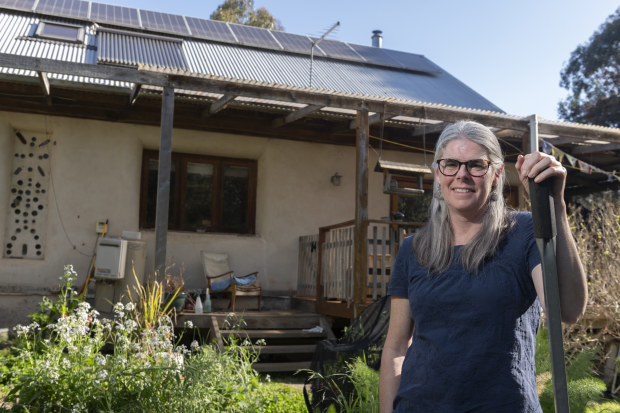She wanted to do the right thing on renewables – but found a $6b bonus

Key Points
- Why it matters: Household solar panels, batteries and electric vehicles will dominate the power grid
- Context: Better management of these resources can help stabilise the grid and reduce emissions
- What’s next: Time-of-use tariffs are needed to encourage more participation in “virtual power plants”
Donna Jones put her hand up for Project Edge – a trial of two-way energy trading among solar rooftop and battery households and businesses – because she wanted to do the right thing and support the grid’s transition from coal power to renewables.
But the project’s sponsors found the collective benefits of better co-ordination of these distributed energy resources for consumers such as Ms Jones could be as much as $5.15 billion to $6 billion over 20 years, plus $3 billion in emissions reductions and a more stable power grid to boot.

Donna Jones of Yackandandah, Victoria, has solar panels and a battery. Jules Boag
“We all know that there are boundless amounts of renewable energy to be had in Australia via wind or sun or whatever it needs to be, and if we can work out how to share that better to make the network work better, then I’ll put my hand up for it every time,” said Ms Jones.
The aged care nurse lives in the Victorian town of Yackandandah with her husband Nigel, three kids, 4.5 kilowatts of solar panels and a 6.5 kilowatt-hour LG home battery.
“It’s all about furthering this new age of electricity and distribution in Australia,” she said. “It’s such an archaic thing to have it as a one-way thing where everyone just buys power off the grid.”
Better co-ordination of rooftop solar panels, batteries, electric vehicles and other “controllable” devices such as hot water systems and pool pumps is vital. That is because, the Australian Energy Market Operator says, they already play a big role in the power grid and will come to dominate it in years to come.
AEMO, one of the sponsors of Project Edge, says more than 100 gigawatts of distributed energy resources will be connected to the eastern states’ National Electricity Market by 2050, or 40 per cent of total installed capacity, under the most likely scenario of its 2022 Integrated System Plan. This will include a fourfold increase in rooftop solar capacity to 69 GW and 31 GW of co-ordinated distributed storage – nearly half of dispatchable capacity – including 7 GW of electric vehicle batteries. A GW is 1000 megawatts.
Failing to better co-ordinate this capacity could cause chaos in the grid, with wild swings in the supply and demand balance and blackouts, a report on Project Edge says. Conversely, better co-ordination will help stabilise the grid as coal power stations are replaced by wind and solar energy.
Project Edge, whose sponsors also included distribution company Ausnet Services and its unregulated networks arm Mondo, aimed to show how a distribution network can host efficient two-way trading in power from co-ordinated distributed energy resources via virtual power plants (VPPs) so that consumers benefit from the transition to net zero.

Donna Jones pictured with, anticlockwise from top left, her solar inverter, battery inverter, Mondo “Ubi” device, battery isolation switch and battery. Jules Boag
VPPs aggregate and manage distributed energy resources to act like a traditional peaking power station by ramping up and down in response to changes in supply and demand. Mondo supplied participants with an “Ubi” device, which was the interface between their solar panels and battery and the network.
The Australian Renewable Energy Agency supported the project; other participants in the trial included Rheem, Discover Energy and AGL Energy. More than 320 residential, commercial and industrial customers took part in the 11-month trial, providing 3.5 megawatts of flexible capacity from more than 400 devices co-ordinated by three different VPPs.
AEMO executive general manager system design Violette Mouchaileh said: “Project EDGE highlights a way forward for co-ordinating distributed energy resources market participation at scale, which will contribute to improve electricity reliability, grid-security, and ultimately affordability.”
The project successfully co-ordinated DER operations between all participants, demonstrating end-to-end technical feasibility of DER to accelerate the transition to net-zero while maintaining energy security and reliability. It also demonstrated that VPPs can provide services to local networks, as well as AEMO wholesale markets.
Arena CEO Darren Miller said the study highlighted “the benefits of developing a marketplace for consumer assets and how integral these will be in Australia’s energy future”.
Mondo’s head of distributed energy, Dhammika Adihetty, said the project showed how businesses and households with solar panels and batteries “can reduce energy costs by joining a Virtual Power Plant while also playing a role in transforming the energy sector”.
Separate trials are being conducted on time of use or “solar soak” tariffs. They reward customers with cheap rates when they buy surplus solar power during the day and with high feed-in tariffs when they inject power into the grid – say from batteries – during evening peak demand periods. High peak tariffs discourage excessive use at those times.
Ms Jones said time-of-use tariffs would make it worthwhile to buy another battery, something she and Nigel – who acquired their first battery in 2017 as part of an earlier microgrid trial – had wanted to do but had not been able to afford yet.
“At the moment it’s not because our feed-in tariff’s, you know, like six cents a kilowatt-hour,” she said. They received lump sum payments for taking part in Project Edge instead.
Introducing your Newsfeed
Follow the topics, people and companies that matter to you.
Find out moreRead More
Latest In Energy & climate
Fetching latest articles